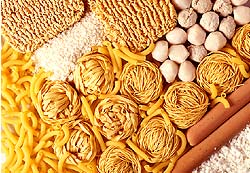Introduction:
Natural starch has been popularly used in many industries. Different applications require different properties of starch. In addition, due to the improvement of production technologies and unceasing development of new products, the stricter needs for starch properties and suitability for its use are required. The properties of natural starch don’t meet sufficiently requirements in the application and processing. As a result, it is necessary to modify starch properties in order to get starch which has properties meet all requirements. Modified starch technologies such methods as: chemical modification, physical or enzyme modification… in order to change within starch granules aiming to change natural properties of starch suitably.
These modified starches can have practical applications in the following fields: textile, pulp and paper, food, feedstuff, foundry, pharmaceuticals and oil drilling. Vedan Vietnam has foreseen the great potentiality of Tapioca starch production in Vietnam and invested large human forces and material resources to comprehensively deploy and promote modified starch production. Currently, the company has been developing the variety of modified starches for wide applications in many industries.
Acetylated Starch:
Acetylated starch is created by a process of natural starch reacting with acetic anhydride or vinyl acetate. Ester groups have effect on the prevention of amylose retrogradation in starch. This modification prevents gelling and weeping and maintains structural appearance of the processed product. This also improves its stability after the freeze-thaw process, improves the water-holding ability and lowers gelatinization temperature of the starch, increasing peak viscidity and improves the gel clarify. The result of this modification is a stable starch used to produce durable pastes through several freeze-thaw cycles and to prevent water leakage. The applications are widely in foods as foundation substance with the good freeze-thaw stability. The extended applications in food industry are the combination of ester starch with cross-linked starch. In paper industry, ester starch can provide extremely viscidity stability.
Oxidized starch:
Natural starch can be processed with a variety of oxidant factors to create oxidized starch. Oxidized starch has a shorter circuit length than natural starch. Oxidation process creates products of stable pliability, improves the whiteness and reduces the number of microorganisms. Furthermore, the hydrogen bonding reduces the retrogradation tendency. Starch gels have the high soft and clarity. Oxidized starch is the best thickening agent for applications requiring gels of low rigidity. This improves adhesion in powder mixing and bread baking.
Diluted solutions of high level oxidized starch remains the clarity after a long time of storage, making it suitable for all kinds of dear or bottled soups and clear confectionery products. Oxidized starch is also widely used for paper surface coating and fabric gluing in the textile industry.
 |
Dual Acetylated Modified Starch and Phosphated Starch:
Cross-linked starch thanks to the acetylating process to form more stable linkage called as Dual Modified Starch and it simultaneously shows properties and functions of Acetylated Starch and phosphated starch.
Excellent freeze-thaw stability, better gel clarity, high temperature resistance, stability in acid environment and strong agitation all are improved. Excellent performance in food processing popularly comprises yogurt, soya sauce, chili sauce, tomato sauce, soups, gravies, puddings, jellies, ham and sausages, canned foods and frozen foods
Cross-linked starch:
Cross-linking is to control starch structure and to provide starch cutting, tearing, acid and heat resistance. Thence, we have better control and flexibility in dealing with formulation, processing and product shelf-life. Cross-linking can be envisioned as “spot weld” among granules at random locations, reinforcing hydrogen bonding and inhibiting granule swell.
Cross-linking make the easily spoiled starches become stronger so that their cooked paste are more viscous and heavy-bodied and are less likely to break down with extended cooking times in the environment of acid or powerful agitation.
This type of starch is suitably applied in low pH, high heat and increased mechanical shear processing.
Acid modified starch:
Unmodified starches are treated with a inorganic acid at temperature lower than gelatinization and as a result, starch molecules is partially hydrolyzed. This cleaves the chain length and reduces the viscidity of starch. It also increases the tendency to retrogradation.
The lower viscidity allows using higher concentrations to form rigid and sustainable gels in gums pastilles and jellies. In these applications, the acid modified starch has the advantage of signification much more than native starch. Extended applications in food industry of acid modified starch often have a combination with starch esterification and etherification reaction.
Cartionic Starch:
Cationic starch represents high performance starch derivatives widely used by paper
 |
manufactures to increase the durability. Cationic starches contain a positive charge over the entire pH range creating their pressure towards negatively charged ground substrates such as cellulose, pulp and some synthetic fibers, aqueous suspensions of inorganic chemicals and slimes and biologically active macromolecules.
Cationic starch clearly improves the retention of fillers. Titanium dioxide, clay, talc and calcium carbonate are frequently incorporated in paper industry to better the opacity of high grade printing paper, writing paper, and light weight paper. With the increase of filler, the sheet will lose its durability because the inert filler reduces the number of sites for fiber-to-fiber bonding. Cationic starch has effect on both improving durability properties and filler retention so it gives high strength properties at high level of filler retention. The reductions of BOD & COD are also achieved in this case.
Other modified starches:
Apart from the above-described modified starches are being produced in Vietnam, we have also others available including Oxidized Starch Acetate for paper coating use, – Cross-link – Oxidized Modified Starches used in cosmetic. Acid Acetylated Modified Starch is used for noodle products that need high flexibility. Octenyl succinated monoester is also developed for powdered seasonings and to provide emulsion with excellent stability. We also supply modified starches for match production and other tailor-made service.
In the future, we will also produce Starch Ether (starch treated with hydroxypropyl groups) to meet the increasing requirements of the market.
These starches are consist of:
|
Name of products |
Symbols of goods |
Properties and applications |
|
Acetylated Starch |
BSF – 7611 BSX – 8850 |
Properties: Clarity, lower gelatinization point, increased stability, low temperature, good water-holding capacity, texturing agents. Applications: instant noodles, frozen foods, ham, sausage, fishball, Chinese dumpling. |
|
Cationic Starch |
JTF – 1046 JTX – 1084 |
Properties : positive charge, increase pulp, fines and fillers retention, increase paper strength and stiffnessmang Applications : Wet-end additive for paper pulp, flocculation agent for surface sizing and waster water treatment |
|
Oxidized Starch |
ETF – 7617 ETL – 1085 ETX – 1073 ETX – 1042 ETM – 1044 |
Properties: good film-forming ability, less water absorption, good sheen and free flowing. Applications : Increase recovery rate of pulp in paper manufacturing industry, waterproof paper |
|
Acetylated Distarch Phosphate |
CBS – 8827 CBA – 8858 CBS – 1068 CBS – 1064 CBL – 8835 CBA – 1063 |
Properties: Increase the stability at low -temperature, good resistance to high temperature, mechanical shear and low pH. Applications: Canned foods, frozen foods, soy sauce, chili sauce, tomato ketchup, soup, gravies, yogurt, meat-ball, fish-ball, pudding and jelly, baked foods… |
|
Phosphate starch |
CTF – 7631 CTM – 7669 CTF – 7655 CTF – 7657 |
Properties: and applications: used as paste and stability increasing agents for foods, fillers for printer, paper industry, producing instant noodles, sausages, fish-ball, meat-ball, etc.. |
|
Acetate oxidized Starch |
EBX – 1032 EBX – 1081 EBS – 1082 EBX – 1093 EBX – 1094 |
Properties: Good flexibility, used as stability agent. Applications: paper industry (plastic), Food industry: wet noodles, snacks, Chinese dumpling, ham, sausages |
|
Octenyl succinate ester |
KSX – 7643 KSM – 7661 |
Properties: good colloidal stability, water-clearing Applications : flavor seasoning, colloidal stability, disposable paper plates |
Package specification of modified starch product:
Packing with paper bags: 20Kg/bag and 50kg/bag
Packing with big bags: 250kg, 500kg, 600kg, 800kg, 850kg, 1000kg
♦ If you have more concerns or any questions relating to our company products, please click on Q&A Inbox to send an email or directly make a free call to hotline 1800599902, employees in charge will give you detailed feedbacks in the shortest time. Wishing you all the best.









